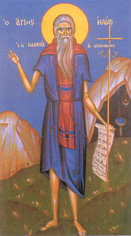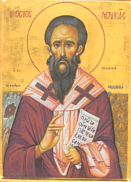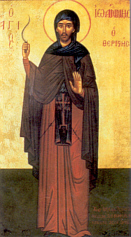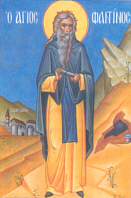



St Elias was born to a wealthy family of nobles in Reggio in Calabria in the year 864. One day a monk approached him in church and upbraided him for his rich clothes and frivolous life. The young man changed at once and at the age of eighteen ran away to Taormina to escape marriage. From here he travelled to Rome to venerate the tombs of the Apostles, but seeing the dissoluteness in the city and its clergy, he returned to Reggio.
Here he found a spiritual father, Arsenius, who tonsured him as a monk. Elias worked very hard and spent his nights in hymns, prayers and genuflexions. He said: 'He who works with his hands and prays in his heart becomes doubly rich, for he serves Christ both as Mary and as Martha'. The two holy fathers always avoided disputes with others and when God revealed to them the forthcoming Saracen/Arab invasion, they both left for Greece. Here, near Patras, they lived for eight years, expelling demons and working wonders.
When the Saracen danger was over, they returned to their monastery of St Eustratius in Calabria and joined with two other ascetics in forming a monastery in a cave. Arsenius became the Abbot but, foreknowing his death, reposed in 904, having chosen Elias the new Abbot. Later, St Arsenius' tomb was opened by the Saracens, who found his relics not only incorrupt but also indestructible.
Advised in a dream to take on new disciples, Elias soon found himself at the head of a large brotherhood. The cave of these troglodytes was now too small for them, but they discovered a much larger cave which they made into a monastery with a church dedicated to the Holy Apostles Peter and Paul. Soon the nearby caves also filled with monks, who followed the example of the life of their Abbot, who taught them how to defeat the demons. Once he worked the miracle of changing water into wine in order to serve the liturgy. Another time he scolded a bear who was destroying the monks' crops: the bear walked away chastened. He gave wise advice to his monks, teaching them obedience by example and protecting them though his prayers. He also did much to improve the customs of the local people and delivered the possessed of demons. Many poor and the sick were drawn to his monastery.
When the Arabs attacked, as they often did, St Elias would either flee into the mountains, hardly eating or drinking, or else would go into the town, upbraiding the inhabitants for their loose morals which had incurred such disasters. In old age, the saint received the gift of tears, but spent the nights before feast-days singing to God in joy. Having predicted his death a year in advance, he went on pilgrimage to the tomb of St Elias of Sicily. He returned, tonsured many novices and then withdrew to his own cave. Here he suffered great pain in silence for twenty-five days, before entering into the heavenly kingdom on 11 September 960, aged 96. He was buried in his cave in the presence of the local Bishop and a great throng of the faithful.
St Elias lived constantly under the threat of the Saracen Muslim attacks. Feasted on 11 September, he should therefore be an intercessor and protector in our own sad times. Let us recall that like other Calabrian saints, he clearly understood and openly proclaimed that the Muslim attacks and invasions of his day were allowed to happen by God on account of the loose morals of the so-called Christians of the age.
After a wasted youth, Nil entered the monastery of St Adrian in Calabria. Here he received the spiritual teaching of St Fantinus in about 940. Later he became Abbot here. In 981 he and his monks were driven out by the invading Muslims to Vellelucio. A great ascetic, St Nil was the founder of several monasteries. A wonderworker and defender of the purity of Orthodoxy, he undertook many journeys simply in order to save another man trouble, for he had a burning love of his neighbour. He entered into his rest in 1005 at Frascati near Rome and designated that place, known as Grottaferrata as a future monastery for his monks. It remains a monastery to this day, though it is now in the hands of Roman Catholics. St Nil left many disciples of great holiness, among them St Bartholomew of Rossano.
Born at Rossano in Calabria, he followed his spiritual father Nil to Grottaferrata near Rome. He excelled as a composer of hymns and canons and he also persuaded Pope Benedict IX to enter the monastic life after his deposition. The latter had been forcibly and illegally deposed as Pope by the German Emperor Henry III in 1048, thus making way for the German Popes who would bring about the Western Schism of 1054. St Bartholomew reposed in 1065.
St Luke was born at Melicucca and was a monk near St Elias the Cave-Dweller. He became a Bishop in Calabria and Sicily and fought untiringly for Orthodoxy during the Papally-sponsored Norman oppression and occupation of the eleventh century.
(See the Life of St Elias the Cave-Dweller)
Son of a noble from Cursano near Stylos in Calabria, John was born in Sicily, where his mother had been abducted by Muslims and forcibly married to an Arab dignitary. Although not baptised, he was brought up in the Faith. When he was 14, he managed to return to Calabria and there was baptised. He decided to emulate the life of St John the Baptist. He joined two ascetics, Ambrose and Nicholas who lived in the monastery on Mt Consolino and became an exemplary disciple. He showed humility and obedience, spending his days in manual work and his nights bathed in the tears of prayer.
One summer's day, he went into the fields with bread and wine to offer to harvesters, notwithstanding their rude banter. As they eat, they became more and more astonished that the quantity of food and drink did not diminish. Overtaken by a thunderstorm, they scattered to find cover. When the rain had stopped, they were amazed to find the harvest completed and in stooks. It was this miracle which gave the name "the Harvester' to St John.
Edified by his miracles, love and humility, his brethren elected him Abbot and the monastery came to take on the name of the saint. After his repose in 1129, miracles continued through the saint's relics for the blessing of the monastery and the town of Stylos which still today honours St John as its patron.
St Zacharias was born at San Severino in Calabria. Although we do not know his date of birth and know nothing of his early life, we do have much more information about his activities from 741 on, when he was chosen to be Pope of Rome.
St Zacharias was not only a persuasive diplomat, but also a highly educated monk and he had already worked closely as the deacon of the previous Pope, the Syrian St Gregory III. Among his achievements were his translation of the Dialogues of St Gregory the Great, the Apostle of the English, into Greek. (It is for this reason that St Gregory the Great is known in Greek as 'St Gregory the Dialogist'). As Pope, St Zacharias was responsible for peacemaking between the Lombards and the Empire and his support for the mission of St Boniface in the barbarian north of Europe.
In this context we have the reply of Pope Zacharias, written in 742 to a letter from St Boniface, concerning the depravity of many clergy in northern Europe. In it St Zacharias affirms the Orthodox teaching on priestly marriage, renounced by the Roman Patriarchate when it fell into Roman Catholicism in the eleventh century:
'If you find bishops, priests or deacons who violate the canons or rules of the Fathers, that is they live in adultery, having more than one wife ... by Apostolic authority you will on account permit them to perform the duties of priests ... How can they believe themselves to be priests, or what do they think of God's Word: 'Let my priests marry once', and the words of the Apostle, 'husband of one wife' etc. And this is lawful only before entering the priesthood; for after that they are prohibited to marry'. (Epistle 51, MGH Ep. Select. I, 87-88).
As an Orthodox, St Zacharias also ardently defended the veneration of icons against the iconoclastic Emperors in Constantinople.
St Zacharias was admired as an energetic administrator who did much to restore and embellish churches, particularly in Rome. He was also renowned for his peace-loving and gentle compassion. He reposed in 752 and was at once honoured as a saint.
St Elias was the Abbot of the monastery of Melicia in Calabria. The monks here were distinguished for their learning and the strictness of their lives. There were so many of them that the region was likened to the Thebaid of Egypt. St Elias entered into his rest in the year 903.
Fantinus was born to a pious Calabrian family in about 927. Since as a boy he showed great devotion to the Holy Scriptures, at the age of eight he was presented to St Elias the Cave-Dweller. Here he was educated and, showing wisdom far beyond his years, he was tonsured monk at the age of thirteen. His first obedience was as cook and as such he acquired the grace of compunction. From the beginning he ate only vegetables and bread once every two or three days at most. He progressed greatly in the virtues and acquired the grace of the Holy Spirit in his heart.
After twenty years in the monastery, he became a hermit in the region of Mt Mercurion in the north of Calabria, where there were a great many monasteries and hermitages. He lived very strictly. Almost naked, he ate only roots and was tormented by demons who tried to make him return to the world or else frighten him in the form of wild animals. He triumphed over them through the sign of the cross and his long prayers. After eighteen years, he was discovered here by his aged parents, whom he persuaded to enter the monastic life together with his two brothers, Luke and Cosmas.
Soon many other men and women entered into the monastic life under the direction of the holy father. But, unable to concentrate on his own salvation, he abandoned this direction to others and retired to a secret place. Here he was arrested by the local inhabitants as a spy and placed in a cell. Fantinus loved this solitude. However, his captors realised their mistake and freed him. Fantinus began to live again as a hesychast, but was constantly interrupted by visitors. Without abandoning his asceticism, he returned to the monastery. He ate raw vegetables, slept on the floor and lived almost naked. His manual work was calligraphy and he gained the gift of unceasing prayer. Having also gained the gift of dispassion, he was able to cast out demons, heal the sick and, like a new Adam, control wild animals, supplying the needs of the monastery through miracles.
Once he entered into such prayer that he remained immobile from dawn till evening. When asked by his disciples what he had seen he said only that it was 'inexpressible'. After this he left the monastery with neither food nor drink and lived naked for twenty days in the mountains. Giving the impression that he was mad, he then correctly predicted the Muslim invasion, which had been allowed by God because of the decadence and immorality of the Orthodox. He was close to St Nil, who later reproached the monks for considering mad one who had had a vision of heaven and hell, having been taken like the Apostle Paul into the third heaven.
Some time after this, an angel appeared to him and told him to go to Greece in order to preach the word of God there and bring souls to salvation. Here he worked many miracles, his reputation going before him, and he healed many and prophesied. For eight years he lived in Salonica, preserving the city from the Bulgarians through his holy prayers and spreading the mercy of God. He reposed in the year 1000 at the age of 73.



